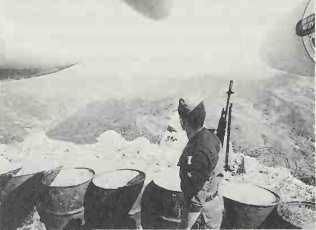Korea, Democratic People’s Republic of State and Government
(North Korea). The dprk was founded on September 9 1948 by Kim II Sung in the former Soviet occupation zone north of the 38th Parallel. It was dominated by the Korean Workers or Communist Party and claimed to represent all of Korea. Soviet troops were withdrawn at the end of 1948 although military advisers remained with the NKPA and economic relations were close. Despite the Russian connection, the regime was never simply a Soviet puppet and there was a strong emphasis on reunification. CM.
Korea, Republic of State and Government (South Korea). The ROK was founded on August 15 1948 in the former US occupation zone south of the 38th Parallel after elections observed by un-TCOK. The government was dominated by the Korean right under Syngman Rhee and claimed to represent all Korea. US troops withdrew in 1949 leaving a military mission with the rok Army. The US also provided economic assistance. Despite American influence, the regime was never simply a puppet and there was a strong emphasis on reunification. CM.
Korean War (1950-1953). Korea, annexed by Japan in 1910, occupies a key strategic position in Northeast Asia. When Japan surrendered in 1945 the US proposed and the Soviet Union accepted the 38th Parallel as the demarcation line between the occupation zones in Korea. At the Moscow Foreign Ministers’ Conference in December 1945, Byrnes and Molotov agreed on the creation of a provisional national government, followed by a period of international trusteeship in Korea. The Moscow Accords, however, were never implemented. Separate administrations, already emerging in each occupation zone, were encouraged by the development of the Cold War. The Russians supported the Korean communists and backed Kim II Sung, a prominent antiJapanese guerrilla. The US Military Government, under Gen Hodge, suppressed the left and backed the right led by Syngman Rhee, an ageing nationalist. In

Holding the un line in Korea, 1950-53
1947 Washington proposed elections under un supervision to create a national government. The General Assembly responded by creating the un Temporary Commission on Korea (untcok). Refused entry into the north, untcok observed separate elections in the south in May 1948. In December the UN recognized the Republic of Korea (rok) under Syngman Rhee. In the north Kim II Sung founded the Democratic People’s Republic of Korea (dprk). Both regimes claimed to represent all Korea.
Except for a group of advisers, Soviet forces left the dprk in December 1948. The North Korean People’s Army (nkpa) founded by Choe Yong Gun was equipped with Soviet tanks and artillery. The last US troops left the south in July
1949. Washington trained and supplied the rok Army but denied it heavy weapons. In 1949 there were clashes along the 38th Parallel and guerrilla warfare in the south. The decision to attack the ROK was taken by Kim II Sung in 1949 and approved by Stalin. Kim wanted to unify Korea while the military balance favoured the north and believed that the Americans would not intervene. On June 25 1950 the nkpa crossed the 38th Parallel, capturing the rok capital Seoul. Although taken by surprise, Washington reacted swiftly. President Truman and his Secretary of State, Acheson, regarded the attack as a Soviet move and believed that further acts of aggression would follow unless they responded firmly. At American prompting and in the absence of the Russian delegate, Malik, the UN Security Council condemned the DPRK, called on un members to assist the rok and established a Unified Command (unc), under Gen MacArthur. Sixteen nations eventually sent contingents. The main ground forces were the US Eighth Army under Gen Walker and ROK troops. The US provided most of the air and sea power. This military effort was supported from US bases in Japan which were allowed to remain by the Japanese peace treaty of 1951. Japan also provided un forces with logistical assistance.
Initially the Americans were unable to halt the nkpa. The first US troops, Task Force Smith, were defeated at Osan on July 5 1950. On July 20 the US 24th Division was driven from Taejon. The Americans were soon clinging to a narrow perimeter around Pusan. In September 1950, however, MacArthur transformed the situation by landing a force under Gen Almond at Inchon, cutting off the NKPA in the south. In October un forces entered North Korea and the General Assembly passed a resolution calling for reunification. While Eighth Army advanced towards Pyongyang, X Corps was landed at Wonsan in the east. These developments alarmed China which feared US troops on its borders. When warnings conveyed through Panikkar, the Indian ambassador to Peking (Beijing), were ignored, Chinese “volunteers” under Gen Peng Dehuai crossed the Yalu river. MacArthur pressed ahead despite the first clash with the Chinese at Unsan. At the end of November his final offensive was defeated at the Chongchon river and the Chosin reservoir and he fell back across the 38th Parallel. Washington now had to decide whether to limit the fighting or to retaliate directly against China. MacArthur argued that he could not hold in Korea without attacking Manchuria. Truman, however, regarded war with China as a Soviet trap which would divert American strength from more vital areas. The best solution was to limit the war and force the enemy to accept a ceasefire. This outcome became possible when the new commander of the Eighth Army, Gen Ridgway, not only held on in Korea but pushed the Chinese back across the 38th Parallel in March 1951. When MacArthur continued to press for a wider war and publicly objected to Truman’s policy, he was fired on April 11 1951.




 World History
World History









